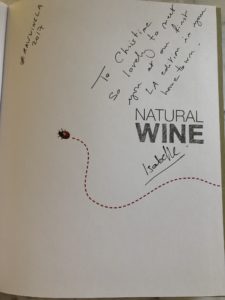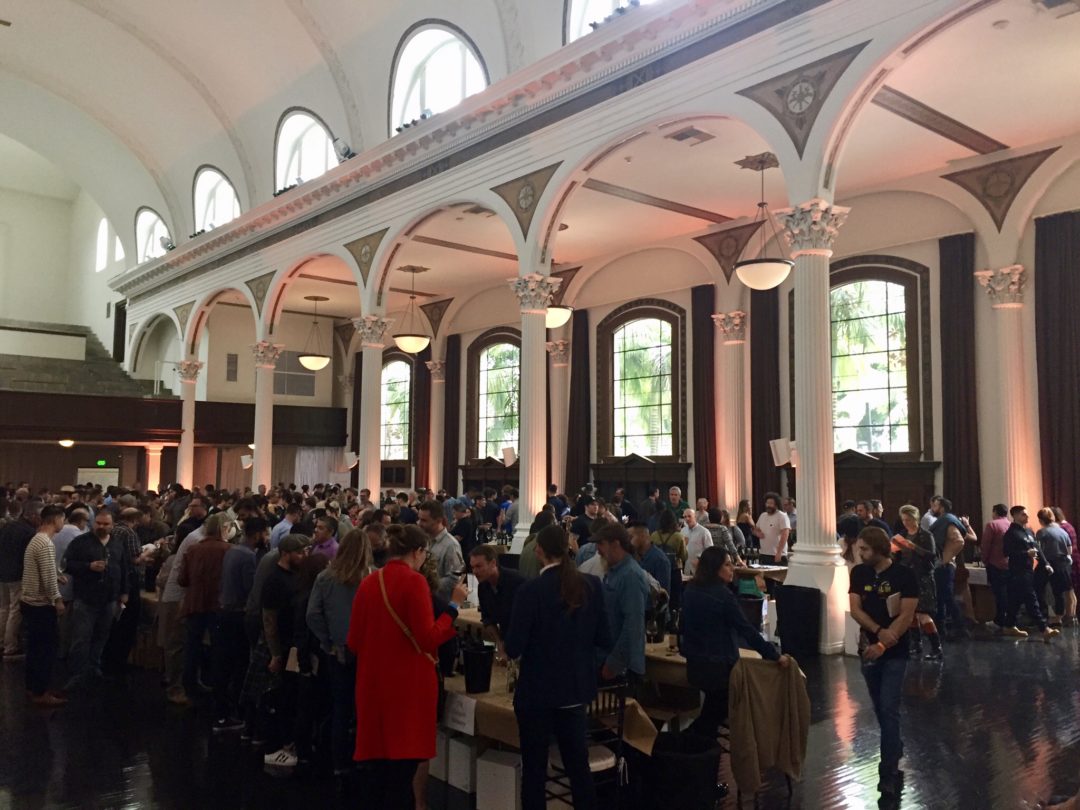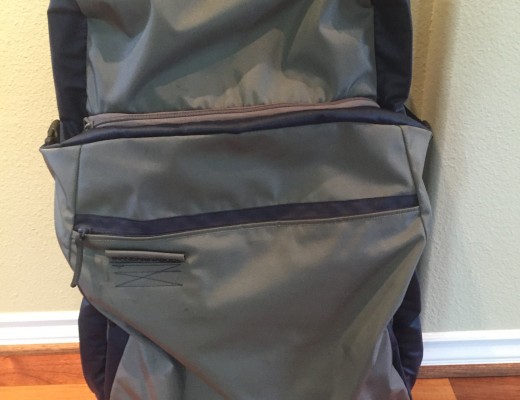After reading Isabelle Legeron’s book Natural Wine at the beginning of 2015, I became curious of this growing sector in the wine world. In May of that year, I attended the RAW Artisan Wine Fair in London. I was very pleased to see that RAW would be coming to LA this year.
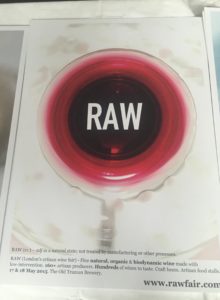
At both fairs, I immediately realised that a new generation of winemakers and wine drinkers is here and making an impact on the world of wine. While this may not be their mom and dad’s wine, it could ironically be the wine of their ancestors from many years ago!

Who is Isabelle Legeron?
Isabelle is the only female French Master of Wine, the most respected title in the wine world. It is held by only 369 people who work in 29 countries in many sectors of the wine business. Besides being a wine consultant in London, a TV host for her shows THAT CRAZY FRENCH WOMAN and Journey Into Wine, her mission is, as put by renowned chef Yotam Ottolenghi, to “show the world the right approach to wine”. Isabelle practices what she preaches and drinks only natural wine. She is “one of the 50 most powerful women in wine”. (Drinks Business, UK)

Isabelle Legeron MW, Founder of RAW Artisan Wine Fair
What is “natural wine”?
Simply defined, natural wine is “wine made as nature intended”, produced from organically and/or biodynamically grown grapes (some certified and some non-certified), farmed manually, utilising minimal intervention, using native yeasts, not filtering or fining, and adding little to no sulphites prior to bottling. Farming is the key to enabling the winemaker to produce his or her wine with the least amount of intervention. Without healthy grapes, it is not possible to produce a well balanced wine that basically goes from vine to fermentation to bottle.
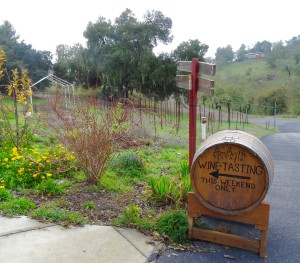
AmByth Estate, Paso Robles, Ca – natural grower/producers and exhibitor at RAW LA 2017 I visited them at their estate in 2016.
What is the RAW Artisan Wine Fair?
The RAW Artisan Wine Fair began in London, expanded to Berlin and next to the US last year, first in New York, and adding Los Angeles this year. RAW is an independent wine fair, gathering together like minded growers/producers who share the concept of living wine that expresses the authentic terroir (sense of place) of its home.
The growers/producers and wines of RAW are polar opposites of the highly manufactured wines of large corporate producers who rely on tricky techniques and additives rather than the grapes themselves. Growers/producers from all over the world come to RAW to showcase and explain their wines to the consumer and those in the wine trade. Some are also seeking representation for distribution.
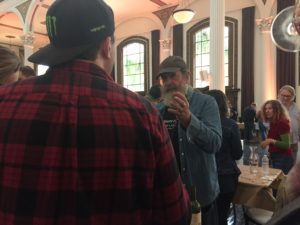
Tony Coturri, veteran Sonoma County natural grower/producer.
What are the RAW Fair criteria for a grower/producer to exhibit
~ The entire vineyard where the grapes are grown must be certified organic and/or biodynamic. An exception can be made for a very small grower for whom certification is cost prohibitive.
~All grapes must be harvested by hand.
~ Malolactic fermentation cannot be blocked.
~ Only a low level of sulfites can be added prior to bottling. No other winemaking additives are permitted. Growers are requested to supply details of their total sulfite levels in each wine they intend to exhibit.
~ Sulfites may not exceed 70 mg/l in any color or style of wine.
~ No “heavy manipulation” is permitted – reverse osmosis or other industry “tricks”.
~ If a wine is fined, the fining agent must be disclosed in order to identify the wine as vegan or non-vegan.
~ Wines are not to be filtered.
~In a difficult year, if chaptalisation or acidification has been used in production, or another additive, the wine may be included in the fair, provided that the additives are disclosed.
(Source: The Artisan Guide 2017)
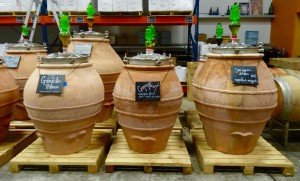
Terra cotta amphorae used in the vinification process at AmByth Estate
RAW LA 2017
The LA event was held November 12 & 13 at Vibiana, the former Roman Catholic Cathedral of the Los Angeles Archdiocese in DTLA.
The venue was perfect in size and layout, with a pleasant and separate outdoor courtyard for the food trucks and tables for lunch and snacks. Also adjacent is Redbird, the upscale restaurant by Chef Neal Fraser.

It’s not an LA event without a food truck!
Over 120 grower/producers from 14 countries were present for the 2 day event. France had the largest representation with 29 grower/producers, followed by Italy and the US with 22 each.
Many types of wine and varietals were represented – PètNat, Sparkling, White, Orange, Red and Rosé.
PètNat, or Pétillant Naturel, is a natural sparkling wine made in the méthode ancestrale with no secondary fermentation, unlike sparkling and Champagne, which are made in the Méthode Traditionale.
Orange wines are made from various white wine grapes, with several days, weeks or even months of skin contact that produce the orange color. By contrast, rosé wines are made from various red wine grapes with very little skin contact, usually just a few hours, and producing a color from pale salmon to a rose pink.
DAY 1
I concentrated on the US and grower/producers I had identified from the London fair that I wanted to revisit.
The US
Most of the US producers are in California – Mendocino, Sierra Nevada Foothills, Sonoma County, Santa Cruz, Paso Robles, Santa Ynez Valley, Santa Barbara County, and San Diego. Oregon, Texas and Ohio were also represented.
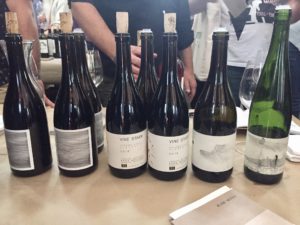
California’s Broc Cellars
For me the standouts in the US were Donkey & Goat’s GIGI sans soufre Syrah, AmByth Estate’s Priscus, a white blend made in a vitrified clay egg, La Clarine Farm’s Mourvèdre/Nebbiolo from volcanic soil, Broc Cellars Counoise, Purity’s Demetria vineyard Syrah, Coturri’s Syrah and the Wabi-Sabi Carignan, Syrah and Zinfandel blend from Populis.
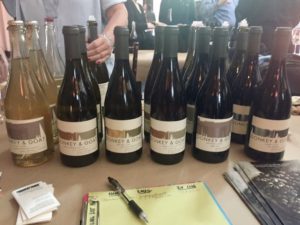
Donkey and Goat
Except for Tony Coturri, who started in 1979, natural wine production in the US is relatively young but growing in production and in popularity by a new generation of wine enthusiasts.
Italy
I was excited about revisiting the volcanic wines of Frank Cornelissen, the well-known Belgian grower/producer in the Mt Etna region of Sicily. I was not disappointed. Mr Cornelissen has vines at various altitudes, like climbing stairs to the top of Mt Etna! Each was very well made, and each showed a differentiation between the characteristics at each altitude. His top of the line wine is, of course, named Magma. The primary grape in these wines is Nerello Mascalese, one that I especially like for its Pinot Noir-like characteristics.
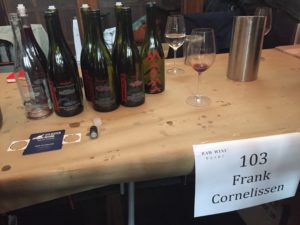
Another on my list was Ampeleia, and they also did not disappoint. The vines grow from 200-600 meters in altitude, in southwestern Tuscany, about halfway between Florence and Rome, with influence from the Mediterranean. Except for Trebbiano, the wines were red, predominately Alicante Nero (Grenache), Carignan and 100% Cabernet Franc. Fragrant, tasty and balanced, they are aged in concrete. All of these were really a treat. I didn’t have a favorite as I enjoyed all of them from Elisabetta Foradori and Giovanni Podini.

Another Italian standout was Foradori, again by Elisabetta Foradori, but this time whites from Alto Adige in the Dolomite foothills of northeast Italy. The grapes are Teroldego and Pinot Grigio, and the soils are alluvial and a calcareous/clay mixture.
What would a natural wine fair be without wines from Georgia, thought to be the birthplace of wine 6000-8000 years ago? The Georgians still use their ancient method of ageing in amphorae, or qvevri, but not the upright amphorae that are becoming more popular today. The Georgians will put them on their side above ground, or bury them in the ground. The most interesting Georgian wine for me was Gotsa’s 100% whole cluster Saperavi pressed rosé, with an interesting brambly taste. All of the grapes in Georgia are indigenous.
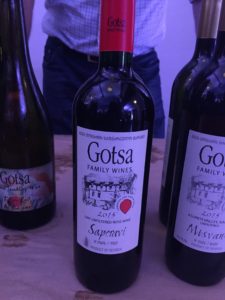
Gotsa Family Winery from Georgia
DAY 2
The second day of the fair was attended primarily by those in the wine trade – sommeliers, restauranteurs, wine shop owners, distributors, etc.
My objective for the day was to concentrate on France and countries with smaller representation – most notably Austria, Spain and Greece.
As I entered I was fortunate to briefly chat with Alice Feiring, author of four books on natural wine, the first of which, The Battle for Wine and Love: Or How I Saved the World From Parkerization, was published in 2008. She launched her natural wine newsletter in 2013, The Feiring Line, to which I subscribe.
France
The natural wines from 29 domaines in France were varying degrees of very good. As I would expect, the largest representation was from Languedoc-Roussillon, in the southern part of France, west of the Rhône and south to the Spanish border.
The standout for me from that area were the Demeter certified biodynamic wines of Domaine de La Réserve, AOC Terrasses du Larzac, an appellation known for exceptional wines of that region. Their red blends were well balanced, with blends of Grenache, Syrah and Cinsault. Their interesting white blend was comprised of Grenache Blanc, Chenin Blanc and Roussanne.
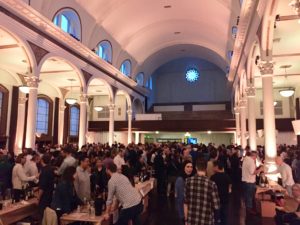
Further west in the Sud Ouest are the wines of Domaine Plageoles in Gaillac. Their white is Mauzac, but their reds are indigenous and different from others I have tasted from that region – Braucol, Duras and Mauzac Noir. Their Vin de Voile, from Mauzac, is sous voile, aged under “veil” for seven years, and is similar to a Jura wine. Very interesting.
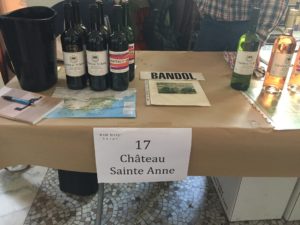
Moving east to Bandol, east of Marseille and Cassis to Château Sainte Anne, where Mourvèdre is the primary red grape, with a minimum of 50%, along with Grenache and Cinsault. Their Bandol Blanc was Ugni Blanc, which is Trebbiano in Italy, has citrus notes and quince. I was very impressed with these well made, complex reds, salmon hued rosés and white from Bandol.
Moving north to Vacqueras in the Southern rhone is Clos de Caveau, formerly owned by Steven Spurrier, the Brit who organized the 1976 Judgment of Paris. Their Bateliers of Grenache and Syrah is lively, fresh and fruity. Also tasted was their Fruit Sauvage, Grenache and Syrah, sweet, but balanced, with ageability of many years.
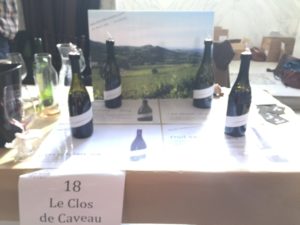
Going further north to the IGP Ardèche, in the Northern Rhone, is where Andrea Calek, originally from what is now the Czech Republic, makes his exceptional red blends of Syrah and Grenache, a pure Syrah, and Pénultième, of Merlot and Syrah. His white is a blend of Chardonnay and Viognier. These wines had complexity and a great mouth feel and were impressive.
Still further north into Beaujolais is Domaine des Côtes de la Molière and the Perrault family’s (farming in Beaujolais for 6 decades) excellent Gamay from the crus of Moulin à Vent and Morgon, and Chardonnay from Pouilly-Fuissé. They also produce a beautiful, natural Chardonnay from Saint-Veran, just north in the Mâconnais of Burgundy.

In Alsace, Domaine Marcel Deiss is renowned for its more traditional Alsatian wines. The younger Mathieu has branched out into his personal project in the natural wine world with his Le Vignoble du Reveur, “The Dreamer’s Vineyard”, where his viticultural practices are organic and biodynamic. He utilises foudres, stainless steel tanks concrete tanks and amphorae of both sandstone for his Gewurtztraminer and clay for his Pinot Gris. Other varietals are also typical of Alsace – Riesling, Pinot Blanc and Pinot Noir. This young winemaker is one to watch.
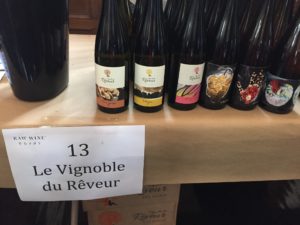
Over to the western end of the Loire is Domaine de l”Ecu, and winemaker Fred Niger. Their vines have been farmed organically since 1975 and biodynamically since 1992. His whites are Melon de Bourgogne, commonly known as Muscadet – perfect for seafood, and his red is Cabernet Franc, in his Mephisto cuvée. All are made in clay amphorae and are very authentic natural wines, as I would expect in the Loire.
Spain
The Demeter certified biodynamic wines of Gratavinum in Priorat, Catalonia, were also a standout. I tasted all red blends that included Carignan, Syrah, Grenache and Cabernet Sauvignon, with each blend distinctive and different. One was, Cotter, was 100% Carignan. Well-balanced and indicative of the black slate and quartzite Licorella soils that impart a special minerality, Gratavinum’s wines were among the best I tasted in my two days.
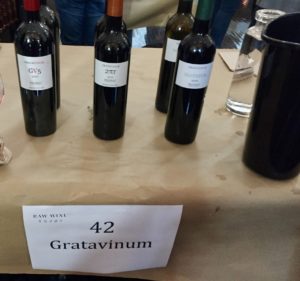
Greece
Greece’s modern wine industry, both natural and traditional, is developing nicely, despite their economic woes. The Georgas family wines of Attika, where Athens if located, surprised me with how Retsina can actually taste good! I was raised in a Greek family and always disliked Retsina. but these were natural and less potent than what I remember. This unique wine is made from the idigenous Savatiano white grape, with Aleppo pine resin added to the must during fermentation. Georgas also makes non Retsina wines from Savatiano.

Austria
I remembered how much I was impressed by the Austrian wines I tasted at the London RAW Fair. I had another great experience with them, especially those from Johannes Zillinger, who took over his father’s organic estate and changed to biodynamic farmic, Demeter certified. His wines I tasted were made from Muskateller, Grüner Veltliner, white Solera and red St Laurent. Johannes is a winemaker to watch. Once again,m I had a very pleasant Austrian wine experience.
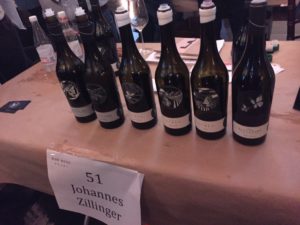
And Finally…
LA’s first RAW Artisan Wine Fair was a success – well received, well organized and well attended. It exposed new people to a different and newer sector of the wine industry, and provided the trade with many options.
In the LA area, look for natural wines at Domaine LA on Melrose, Lou Wine in Los Feliz, Silverlake Wine in Silver Lake, Highland Park and DTLA, Bar & Garden in Culver City and at several restaurants in LA. Hopefully there will be wider distribution outside LA in shops and restaurants in the near future.
Santé!
